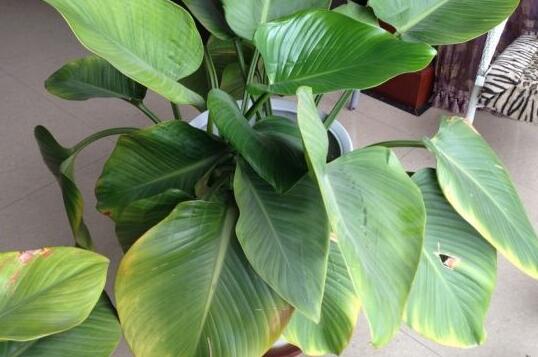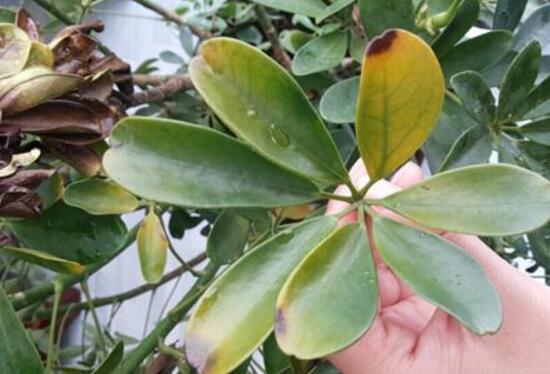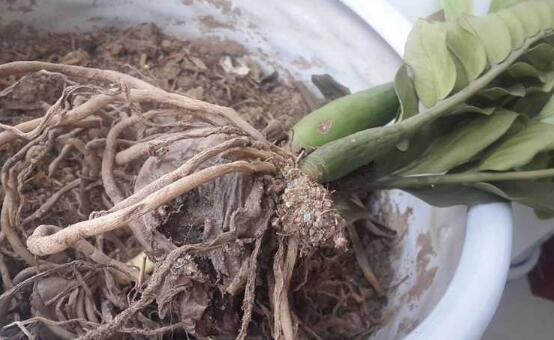What if the golden diamond leaves turn yellow? six reasons make the leaves withered and wilted / with solutions.
Gold diamond is a perennial evergreen plant, its leaves should be kept green all the year round under normal circumstances, but due to the different cultivation environment and methods of each flower friend, some flower friends will encounter the phenomenon of yellowing leaves, which is a headache, so what about yellow gold diamond leaves? Xiao Bian believes that the main reasons are as follows:
What about yellow gold?
1. Temperature discomfort

The adaptability of gold diamond to temperature is relatively strong, but its most suitable temperature is 20-30 degrees, if the temperature is lower than 10 degrees or higher than 35 degrees, the leaves will easily become yellow and dry.
Solution: Pay attention to the change of ambient temperature. When the temperature is too low or too high, take certain measures to cool down or keep warm, such as putting a cool place in summer, moving back indoors in winter, etc.
2, humidity is too low
In the cultivation method of gold diamond, we know that it likes to grow in an environment with humidity of 50-70%. If the humidity is relatively low, it will not only cause the leaves to yellow, but also cause the leaves to droop, which will seriously affect its beauty.
Solution: When the air is relatively dry, you can use a watering can to fill some water around the plant, foliage spray some water to increase air humidity.
3. Light discomfort
Gold diamond belongs to shade-loving plants, it is not suitable for growth in full light environment, especially in summer can not be exposed to sunlight, if the light is too strong, the leaves will appear burns phenomenon. Of course, there can be no long-term lack of light, otherwise the leaves will lose green and slowly turn yellow and wither.
Solution: How to do yellow gold diamond leaves caused by light discomfort? The first thing to do is to move the gold diamond to a semi-shady environment for maintenance, followed by avoiding it from direct sunlight at ordinary times.
4. Excessive fertilization
If the old leaves of the gold diamond turn yellow and fall, and the new leaves show unevenness, you can check whether the recent fertilization is excessive. If the fertilizer concentration is relatively high and frequent fertilization, the yellow phenomenon will appear, and the result is yellow gold diamond leaves.
Solution: Stop fertilizing. If the excess fertilizer is not high, you can water more to reduce the concentration, but you need to do a good job of drainage. When the excess is relatively high, some cabbage seeds can be buried in the soil and pulled out after germination.
5. Frequent watering
Some flower friends think that gold diamond is like wet environment, so often water it, every time watering is always a lot of watering, so that the soil is always too wet, this is very harmful to the roots, its result is yellow leaves.
Solution: Reduce the number of watering times, so that the soil is properly dry, if the yellowing phenomenon still does not improve after a period of time, you can take off the plant pot to check the root growth, if there is rotten root to cut off in time, and then replace the pot soil re-planting.
6. Caused by pests and diseases
The main harm object of pests and diseases is the leaves and roots of gold diamond. If the juice in the leaves is absorbed, it will not only cause yellowing but also have their own disease spots, but also continue to infect other leaves, which needs timely treatment.
Solution: Find out the cause of the disease, the method can refer to the pest control method of gold diamond, usually do a good job of maintenance management, keep the environment suitable to reduce the probability of pest occurrence.
How to deal with yellow leaves of yew, five reasons for comprehensive consideration/with solutions
Although yew is a relatively precious plant, but yew breeding method is not as difficult as imagined, but also need to understand some skills when planting, otherwise it may cause the phenomenon of yellow leaves, and yew leaves yellow how to do? Here are a few common causes and solutions to do a detailed introduction.
What about yellow leaves?
1. The watering problem
Although yew drought tolerance is not the strongest, but it can still survive in slightly dry soil, if watering too much will lead to rotten roots, and watering too little will lead to dull leaf surface, the top of the new shoots will also wilt, that is, flower friends often say water yellow, drought yellow phenomenon.
Solution: remove the yellow leaves, and then reasonable watering, in the yew how to water we have done a detailed introduction, flower friends can be used as a reference. In addition, pay attention to good soil ventilation and drainage, so as to ensure that the water poured in can be absorbed by the roots, and when watering, you can add some agents to prevent rotten roots.
Second, the lighting problem
1. The light is too strong. Yew is also known as yew, it is actually a shade-loving plant, if it is often exposed to sunlight, will lead to excessive consumption of water in the tissue, then the leaves may be burned and yellow.
2. The light is too weak. In addition to too much sunlight, lack of light is also one of the reasons for yellowing leaves, because its leaves need normal photosynthesis, if the light is too weak, it will affect the progress of photosynthesis, then the leaves will be yellow if they grow poorly.
Solution: What about the yellowing of yew leaves caused by light problems? When breeding, it should not be exposed to sunlight, nor should it be placed in a dimly lit place for a long time. It is ideal to see scattered light for 4-5 hours a day.
III. Humidity problem
Humidity is often overlooked, but it is still important for the growth of Taxus chinensis. If the environment is humid and the humidity is suitable, its growth will be smooth. On the contrary, if the humidity is low and the air is dry, the leaves may quickly dehydrate and curl yellow.
Solution: Pay attention to the environmental humidity, if the air is relatively dry, you can spray some water to the leaves with a spray can, not only to wash the leaves to make it better, but also to increase the humidity of the surrounding air, of course, when spraying water, do not overdo it, causing ponding instead will have a bad effect.
IV. Temperature problem
1. The temperature is too high. Taxus was originally grown in semi-shady slope places, it is most like the cool climate, if the temperature is too high, may cause some old, weak growth of leaves early yellow fall.
2, the temperature is too low. Under normal circumstances, yew is able to withstand temperatures below minus 30 ° C, but if it is exposed to ultra-low temperatures for a long time, some leaves will inevitably turn yellow.
Solution: What about the yellowing of yew leaves caused by temperature? Control the temperature not too high or too low, if the summer temperature is higher, you can take cooling measures, such as spraying water or moving to the shade, etc. In winter, when the temperature difference between day and night is large, pay attention to cold prevention.
V. Environmental issues
Newly bought yew, or suddenly moved to another place where the environment changes greatly, may also cause yellowing of the leaves, because it takes a period of time to adapt, which is called slow seedling in many plant cultivation.
Solution: Try to ensure that the environmental changes are not too large, such as suddenly letting it be in the exhaust vent, etc., try to ensure that the environment is stable, and there is no excessive temperature difference between day and night, more and less watering, etc.
What about yellow leaves? causes and solutions
Green radish is a large evergreen vine belonging to the genus Kirin leaf of Araceae. It grows in tropical areas. It often climbs and grows on the rocks and trunks of rainforests. Its adaptability is very strong. It lives in water. It is called "flower of life" because of its tenacious vitality. It has high ornamental value. It can also absorb benzene, trichloroethylene, formaldehyde, etc. in the air. Let's take a look at how to do yellow leaves of green radish!
Insufficient moisture causes leaf edges to wither
[Reason] If there is insufficient water in the soil of green radish, it will cause the edges of the leaves to dry and yellow, and the leaves will fall off.
[Method] It is necessary to pour enough water on the green radish in time.
Too much water causes dark yellow leaves
If the moisture in the soil or container of green radish is too sufficient, it will also cause the leaves to yellow, the leaves will appear dark yellow and dull, and even the roots will rot.
[Method] It is necessary to stop watering and loosen the soil properly.
Direct sunlight causes leaves to wilt
[Reason] Green dill grows in a cool environment, so placing green dill under strong light for a long time can easily cause leaves to wither and wilt, and then turn yellow and fall off.
[Method] It is necessary to put the green radish in a cool place with light and water it properly.
Dim light causes new leaves to turn yellow
If the green radish is placed in a dark and unventilated place for a long time, the green leaves will be yellow due to lack of chlorophyll, especially the newly grown leaves.
[Method] It is necessary to keep the green radish in a cool and well-lit place.
Too much fertilization causes old leaves to fall off
[Reason] If too much fertilizer is applied to green radish, it will accumulate excessive nutrients in the old leaves, and then it will turn yellow and eventually fall off.
[Method] Reduce the number of fertilizers and irrigate water to dilute the fertilizer in the soil.
Insufficient fertilization causes yellowing of roots and leaves
[Reason] Green radish lacks nutrition. When fertilization is insufficient, the color of leaf surface will gradually turn pale and yellow, especially the leaves at the root will turn yellow first and fall off.
[Method] More fertilization is needed.
Poor ventilation causes green leaves to turn yellow
[Reason] The growing environment of green radish requires ventilation and shade. The indoor temperature in winter should not be too hot. Attention should also be paid to ventilation. Otherwise, dry heat will also cause green leaves to turn yellow.
[Method] It is necessary to open windows for ventilation and water more to ensure nutrition.
Yellow leaves are normal.
[Reason] Green radish to adapt to the new environment, generally about 30 days, during which individual old leaves will appear yellow signs, this is a normal phenomenon, in the running-in period.
[Method] Don't be too anxious to take measures. When it returns to normal, the green radish will grow vigorously.
- Prev

What about the yellowing of the leaves of the cash cow? pay attention to the yellowing at 6 o'clock.
Cash cow, just listen to the name makes people like, coupled with its own good-looking, so many people keep at home. However, indoor farming is not as good as outdoor breeding, especially for beginners, they often cause leaves to turn yellow because of improper maintenance. So, what if the leaves of the cash cow turn yellow? To this
- Next

What about the rotten roots of the cash cow? remedial measures for the rotten roots of the cash cow / cutting and replanting
The cash cow, named for its leaves like copper coins, is a beautiful foliage plant. In life, many people raise a cash cow at home, not only because it is good-looking, but also because it means good. But in the process of breeding, for various reasons, the cash cow will have rotten roots, thus affecting the ornamental.
Related
- Fuxing push coffee new agricultural production and marketing class: lack of small-scale processing plants
- Jujube rice field leisure farm deep ploughing Yilan for five years to create a space for organic food and play
- Nongyu Farm-A trial of organic papaya for brave women with advanced technology
- Four points for attention in the prevention and control of diseases and insect pests of edible fungi
- How to add nutrient solution to Edible Fungi
- Is there any good way to control edible fungus mites?
- Open Inoculation Technology of Edible Fungi
- Is there any clever way to use fertilizer for edible fungus in winter?
- What agents are used to kill the pathogens of edible fungi in the mushroom shed?
- Rapid drying of Edible Fungi

